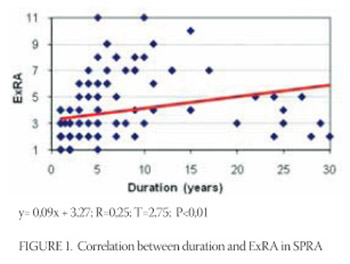Extra-Articular Manifestations of Seronegative and Seropositive Rheumatoid Arthritis
DOI:
https://doi.org/10.17305/bjbms.2010.2729Keywords:
rheumatoid arthritis, seropositive, seronegative, extra-articular manifestationsAbstract
Although considered a “joint disease,” rheumatoid arthritis is associated with the involvement of extra-articular manifestations. The aim of the study is the investigation and comparison of frequency and type of extra-articular manifestations in a well defined community based cohort of patients with seropositive and seronegative rheumatoid arthritis. Using the ACR (1987) criteria for rheumatoid arthritis, patients have been classified into the 2nd and 3rd functional class (ARA). The studied group consisted of 125 seronegative patients with titters lower than 1:64 as defined by Rose-Waaler test, whereas the control group consisted of 125 seropositive patients with titters of 1:64 or higher. All patients were between 25-60 years of age (Xb=49,96), with disease duration between 1-27 years (Xb=6,41). In order to present the findings of the study, the structure, prevalence, arithmetic mean (Xb), standard deviation (SB), variation quotient (QV%) and variation interval (Rmax-Rmin) have been used. Probability level has been expressed by p<0,01 and p<0,05. Correlation between the number of extra-articular manifestations and duration of the disease has been calculated by means of Pearson linear correlation. Higher presence of diffuse lung fibrosis, central and peripheral nervous system damages have been confirmed in the seropositive group, and osteoporosis in the seronegative; however, no statistical difference has been found. In extra-articular manifestations, “rheumatoid core” in the seropositive subset (χ2=4,80, p<0,05) presented significant statistical difference. Rheumatoid nodules were more frequent in seropositive subset (12%:16%), in both sexes; however, they were not of significant statistical difference. Neuropathy and lung diseases were also frequently present in seropositive group, but no statistical difference has been found regarding the statistical difference. Longer duration of the disease resulted in an increase of the number of extra-articular manifestations. Calculated linear correlation by Pearson, resulted as positive and high correlation in total (r=0,36, p<0,01), and for groups [(r=0,52, p<0,01) seronegative, (r=0,25, p<0,01) seropositive], nevertheless no significant statistical difference was found regarding the serostatus. In conclusion, extra-articular manifestations are more frequent in the seropositive patients. The longer the duration of the disease the larger the number of extra-articular manifestations. Differences with regard to sero-status and sex, with some exceptions, are not observed.
Citations
Downloads

Downloads
Published
How to Cite
Accepted 2017-11-28
Published 2010-02-20









